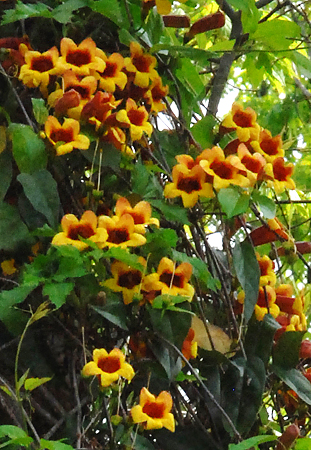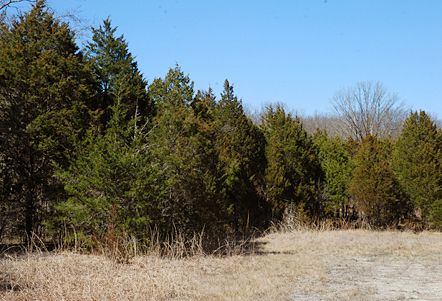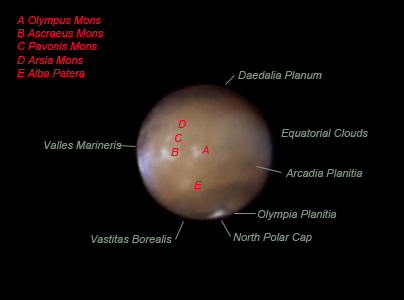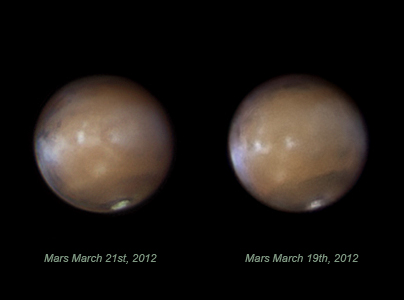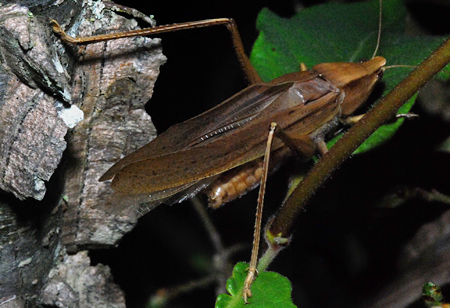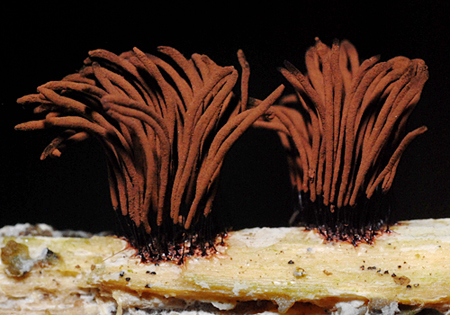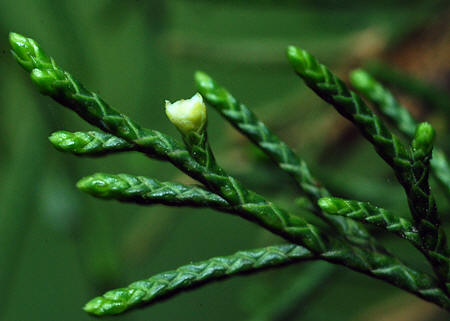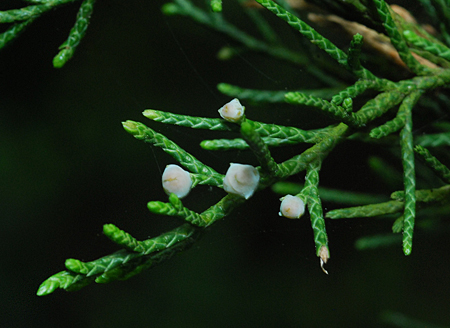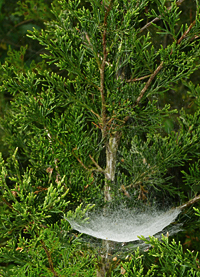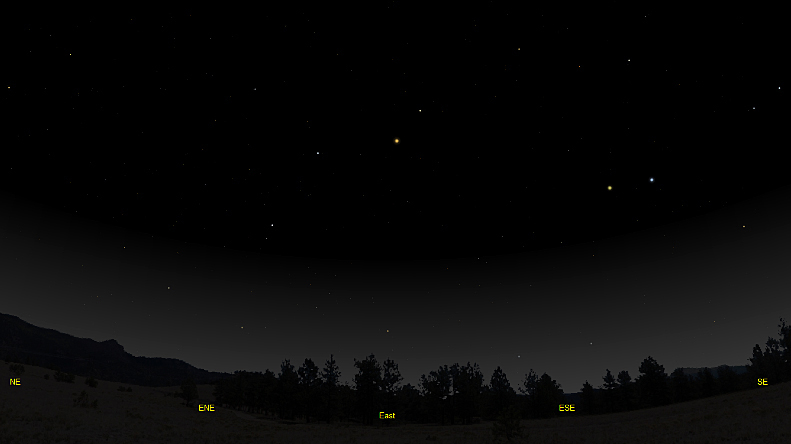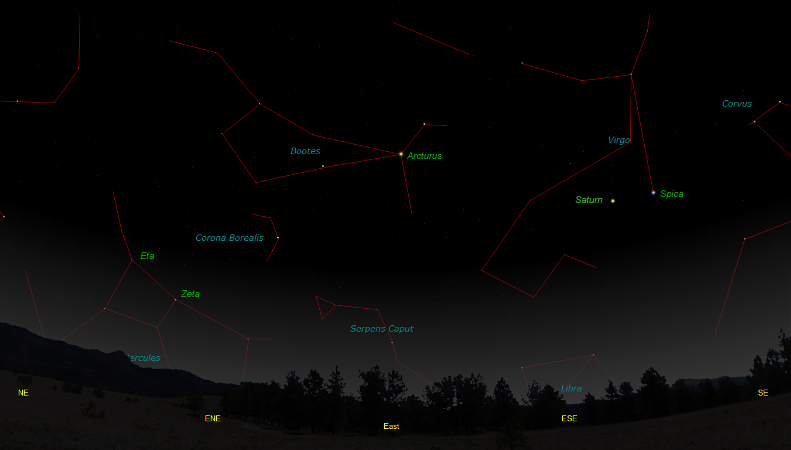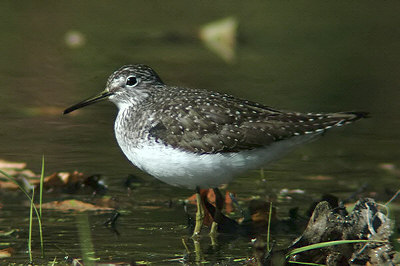The purpose of this feature is to give scout leaders, educators and naturalists an idea of some of the natural events coming up each month. We will try to cover a variety of natural events ranging from sky events to calling periods of amphibians, bird and mammal watching tips, prominent wildflowers and anything else that comes to mind. We will also note prominent constellations appearing over the eastern horizon at mid-evening each month for our area for those who would like to learn the constellations. If you have suggestions for other types of natural information you would like to see added to this calendar, let us know! Note: You can click on the hyperlinks to learn more about some of the featured items. To return to the Calendar, hit the "back" button on your browser, NOT the "back" button on the web page. All charts are available in a "printer friendly" mode, with black stars on a white background. Left clicking on each chart will take you to a printable black and white image. Please note that images on these pages are meant to be displayed at 100%. If your browser zooms into a higher magnification than that, the images may lose quality. Though we link book references to nationwide sources, we encourage you to support your local book store whenever possible. Notes and Images From March 2012
What an unusual spring! The unseasonably warm temperatures have caused many natural happenings to occur two to three weeks earlier than normal. Eastern Redbuds were beginning to bloom by the first week in March this year. By the end of the month, Flowering Dogwood, Black Cherry and Black Locust were in full bloom. The bright red and yellow flowers of Crossvine, shown at right, added a burst of color to the rapidly greening landscape. Frog and toads that we usually don't hear until May began calling this month (see the section on amphibians below). While the warmer than normal temperatures have made for some pleasant days, we miss the early brisk morning temperatures that we normally experience this time of year. We're also a little concerned that if this warming trend continues, we may see colder weather species like the Wood Frog disappear from the landscape of Middle Tennessee.
On March 5th we spent a pleasant morning at Flat Rock Natural Area near Murfreesboro. Flat Rock is a cedar glade that is open year round and is a home to several threatened and endangered species. According to the Nature Conservancy, cedar glades are among the rarest habitat types in the Southeastern United States, and are characterized by a mosaic of limestone outcroppings, dense cedar thickets, upland forests, and grass-dominated barrens. You can find the Nature Conservancy web page on the Flat Rock Natural Area here.
One of the more common winter annual wildflowers typical of the glade habitat is the Long-styled Glade Cress shown at left. Other rarer plant species found at Flat Rock include Pyne's Ground Plum, Leafy Prairie Clover and Blazing Star. A 3.5 mile trail winds through the cedar glade. For more about cedar glades in Tennessee you can visit the excellent web site of the Center for Cedar Glade Studies at Middle Tennessee State University. This multimedia site has a wealth of information about cedar glades in Tennessee.
We spent a couple of pleasant evenings imaging Mars on March 19th and March 21st. The face of Mars that was visible, shown at right, included some of the most interesting surface features on the planet. Particularly striking were the orographic clouds that form over the Martian volcanoes, such as Olympus Mons. These clouds are labeled in red in the image. They were known even to 19th century observers like Schiaparelli. Most prominent was the cloud over Olympus Mons. Schiaparelli noted that even when Martian dust storms obscured all other surface features on the planet, this white spot remained visible. He made a shrewd guess that the spot was still visible because it was at high altitude, above the obscuring dust. He named it Nix Olympica, Latin for "the snows of Olympus".
It was not until the Mariner spacecraft missions of the 1960's that it was discovered that Schiaparelli's Nix Olympica was indeed a high cloud over a mountain. That mountain is the highest known mountain in the solar system, and was christened Olympus Mons. Olympus Mons towers over 70,000 feet above the surrounding plains. It's base covers an area about the size of the state of Missouri. Seen at left are images taken on the two evenings. The planet has rotated a little between shots but if you look closely at the clouds over Ascraeus Mons, for instance, you can see subtle changes in the structure of the clouds that have taken place in the 48 hour interval between the two images. The giant canyon Valles Marineris is just rotating into view on the left side of the planet.
On the night of March 19th we heard a new insect call from our field. We first thought it was a species of cricket, but the call sounded too high and fast. It sounded a little like a conehead, but we usually don't hear coneheads till sometime in June. We recorded the call, and found that it was at a fairly high frequency, around 10,000 hertz. It was a somewhat electrical-sounding buzz interrupted by very short and abrupt pauses. Not finding the call in Lang Elliott and Wil Hershberger's excellent Songs of Insects web page, we made inquiries to the authors of that site. They suggested that it possibly was an overwintering species of katydid or conehead. Following up on that suggestion, we checked the University of Florida's great Singing Insects of North America web site, and found that the Broad-tipped Conehead's spring song on that site matched our recorded song perfectly. I sent our recording to Thomas Walker, who created the site, and he confirmed the identification. So with the help of some very knowledgeable (and patient) people, we did come up with a name for our mystery call. After several attempts, we managed to get the above image. This male, like approximately 95 percent of all overwintering males, is in the brown color phase . The Broad-tipped Conehead is the only Conehead in North America whose cone is broader than it is long. Unlike our summer-calling conehead species, this overwintering species calls only in the spring in our area. For more on inexpensive ways to record natural sounds and view their sonograms, see our Recording Natural Sounds page. Note 04/16/2012: We did not heard our conehead during early April when nighttime temperatures dropped. Apparently, the minimum nighttime air temperature it requires for calling is close to 70 degrees Fahrenheit. We've started hearing it again the last few evenings when the temperatures have been around 70 degrees F.
Spring is the time when many people's thoughts turn to slime molds. Okay, that's a bit of a stretch, but we found this colorful and interesting species on March 25th. The common name for this species is Hair on Wood. The scientific name is Stemonitis axifera. This species grows on decaying wood and is common in our area. The slime molds used to be classified along with the fungi, but have now been put in the kingdom Protista.
Last month we talked about the male and female cones of our Eastern Redcedar. The male cones appear quite early in the year and produce an incredible amount of pollen. On that page we showed an image of the more mature female seed cones taken around the middle of May. We wanted to also show the developing female seed cones. The image at right was taken on March 31st of a developing female seed cone in a cedar in our front yard. Notice the yellowish color of the developing cone.
We also found some female cones on the same tree that were just a bit farther along in their development. Shown at left is a group of female cedar seed cones. As you can see, they are beginning to develop the characteristic powder blue color of the mature female seed cones. You can see the mature seed cones in the March, 2012 Natural Calendar.
Finally, on foggy mornings this time of year, it's hard to miss one abundant resident of our area. Bowl and Doily Spiders, also sometimes called Cup and Doily Spiders, build bowl-shaped webs that show up particularly well on foggy mornings, when dew condenses on the web. These spiders (scientific name Frontinella communis) are a species of sheet weaver spiders. Their habitat is weedy fields and shrubs. Only about 4mm long, they sit beneath their bowl-shaped web and wait for prey to tumble into the web.
The web, shown at left, consists of the bowl-shaped structure above and a flat plate-like web beneath (the "doily").* The bowl is suspended from overhead branches by thin strands of web. Most of the web strands are not sticky, so prey that falls into the bowl slips to the bottom of the bowl. The spider, waiting beneath the bowl as shown in both images, then seizes the prey and pulls it through the web and wraps it up. The structure of the web may help protect the spider from predators both from above and below. Prey includes small flies, gnats and other small insects. *For those new to the term, a doily is a small ornamental mat, usually of lace or linen. Sky Events for April 2012: The Lyrid Meteor Shower peaks on the morning of April 22nd. The conditions for this shower are good, with no moonlight interfering. However this shower, even in excellent dark skies, has only produced around a dozen meteors per hour in recent years. Evening Sky: At the beginning of the month, look for Jupiter low in the western sky at dusk, about 23 degrees above horizon. Venus will be above Jupiter and about 40 degrees above the horizon. Venus is much the brighter of the two planets and will be visible before Jupiter. Jupiter will get lower in the west each day as the month progresses, until by month's end it will be difficult to pick out of the twilight glow. Look for Mars about 50 degrees above the eastern horizon at dusk on April 1st. It's beginning to fade now, and telescopically its apparent size will shrink from 12 seconds of an arc to around 10 seconds of an arc by the end of the month. Still, better try to catch a glimpse now - it will be a little over two years until the next close approach. To see which side is visible, I recommend the Mars Profiler at the Sky and Telescope web site. Saturn rises at dusk on April 1st in Virgo. Best views through the telescope occur when it is due south around 2:00am. The ringed planet reaches opposition on April 15th. Saturn is stunning in just about any size telescope. See if you can make out Cassini's division in the rings, which appears like a thin black division in the rings. Those using larger telescopes can try for the faint "Crepe" ring, the translucent innermost ring of the ring system, or Encke's division, a faint division in the outermost ring. Finally, look for a very thin crescent Moon about 30 minutes after sunset on April 22nd. Binoculars should help spot the slender crescent. Morning Sky: Mercury will reach greatest western elongation, rising before the Sun, on April 18th. This is a poor apparition though, with the planet very difficult to pick out of the dawn glow. Constellations: The views below show the sky looking east at 9:30pm CDT on April 15th. The first view shows the sky with the constellation outlined and names depicted. Star and planet names are in green. Constellation names are in blue. The second view shows the same scene without labels. Bright objects in the eastern sky this month include the stars Arcturus and Spica, and the planet Saturn. New constellations are Serpens Caput, the Serpent (Head), and Hercules, the Strongman. As spring progresses and Hercules rises higher in the sky, look for the globular cluster Messier 13 (M13), which appears like a small fuzzy patch of light about 1/3 of the distance from Eta to Zeta Hercules (see illustration below). A cluster of stars about 21,000 light years away, M13 can be made out with the naked eye in a dark country sky when the constellation is high in the sky. Binoculars will help pick it out.
On Learning the Constellations: We advise learning a few constellations each month, and then following them through the seasons. Once you associate a particular constellation coming over the eastern horizon at a certain time of year, you may start thinking about it like an old friend, looking forward to its arrival each season. The stars in the evening scene above, for instance, will always be in the same place relative to the horizon at the same time and date each April. Of course, the planets do move slowly through the constellations, but with practice you will learn to identify them from their appearance. In particular, learn the brightest stars (Like Arcturus and Spica in the above scene looking east), for they will guide you to the fainter stars. Once you can locate the more prominent constellations, you can "branch out" to other constellations around them. It may take you a little while to get a sense of scale, to translate what you see on the computer screen or what you see on the page of a book to what you see in the sky. Look for patterns, like the stars that make up the constellation Corona Borealis. The earth's rotation causes the constellations to appear to move across the sky just as the sun and the moon appear to do. If you go outside earlier than the time shown on the charts, the constellations will be lower to the eastern horizon. If you observe later, they will have climbed higher. As each season progresses, the earth's motion around the sun causes the constellations to appear a little farther towards the west each night for any given time of night. If you want to see where the constellations in the above figures will be on May 15th at 9:30pm CDT, you can stay up till 11:30pm CDT on the April 15th and get a preview. The westward motion of the constellations is equivalent to two hours per month. Recommended: Sky & Telescope's Pocket Star Atlas is beautiful, compact star atlas. It is destined to become a classic, and is a joy to use at the telescope. A good book to learn the constellations is Patterns in the Sky, by Hewitt-White. You may also want to check out at H. A. Rey's classic, The Stars, A New Way to See Them. For skywatching tips, an inexpensive good guide is Secrets of Stargazing, by Becky Ramotowski. A good general reference book on astronomy is the Peterson
Field Guide,
A Field Guide to the Stars and Planets, by Pasachoff. The book retails for around $14.00. Starry Night has several software programs for learning the night sky. Visit the Starry Night web site at www.starrynight.com for details.
Amphibians:
What a crazy spring! Already this spring we've heard Upland Chorus Frogs, Spring Peepers, Southern Leopard Frogs, American and Fowler's Toads, Northern Cricket Frogs and Gray Treefrogs. The early calls of Gray Treefrogs sound raspier than the normal trill, as if the frog needs to clear its throat. Listen also on warm days for American Bullfrogs and Green Frogs. Early April is also a great time to listen for the "yeeooww" calls of Pickerel Frogs. With the warm weather, you can expect just about anything. Recommended: The Frogs and Toads of North America, Lang Elliott, Houghton Mifflin Co.
Birds:
The spring migration builds very quickly in April. The neo-tropical migrants are too numerous to list here, but now is the time to get out in the early morning with a pair of binoculars and welcome the new arrivals for the day. Scan the edges of ponds and creeks for Solitary and Spotted Sandpipers. Early arrivals also include Black-and-white Warbler, Black-Throated Green Warbler, Louisiana Waterthrush and Blue-gray Gnatcatcher. Listen at dusk for young Great Horned Owls and Young Barred Owls, doing their raspy "begging" calls. Recommended: The Sibley Guide to Birds, David Allen Sibley The Sibley Guide to Birds of Eastern North America, David Allen Sibley An inexpensive guide for beginners is the Golden Guide for Birds.
Wildflowers: Some of our favorite Spring wildflower walks are: The south ridge at the Owl's Hill Nature Center in Brentwood, Tennessee. The Edwin Warner paved loop at the Warner Parks in Nashville or just about any trail in Warner Parks. The Angel Falls trail along the Cumberland River at the Big South Fork Recreational Area, near Jamestown, Tennessee.
Archives (Remember to use the back button on your browser, NOT the back button on the web page!) Natural Calendar February 2012 Natural Calendar December 2011 Natural Calendar November 2011 Natural Calendar September 2011 Natural Calendar February 2011 Natural Calendar December 2010 Natural Calendar November 2010 Natural Calendar September 2010 Natural Calendar February 2010 Natural Calendar December 2009 Natural Calendar November 2009 Natural Calendar September 2009 Natural Calendar February 2009 Natural Calendar December 2008 Natural Calendar November 2008 Natural Calendar September 2008 Natural Calendar February 2008 Natural Calendar December 2007 Natural Calendar November 2007 Natural Calendar September 2007 Natural Calendar February 2007 Natural Calendar December 2006 Natural Calendar November 2006 Natural Calendar September 2006 Natural Calendar February 2006
Natural Calendar
December 2005
Natural Calendar
November 2005
Natural Calendar
September 2005
Natural Calendar
February 2005
Natural Calendar
December 2004
Natural Calendar
November 2004
Natural Calendar
September 2004
Natural Calendar
February 2004
Natural Calendar
December 2003
Natural Calendar
November 2003
Natural Calendar
September 2003 Natural Calendar February 2003 Natural Calendar December 2002 Natural Calendar November 2002 Nature Notes Archives: Nature Notes was a page we published in 2001 and 2002 containing our observations about everything from the northern lights display of November 2001 to frog and salamander egg masses. Night scenes prepared with The Sky 6 Professional from Software Bisque All images and recordings © 2012 Leaps |
|||||||||||||||||||||||||||
